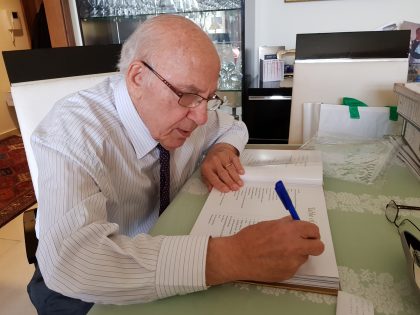
Azad-Hye
Berj Aprahamian was born in 1931 in the Armenian Quarter of Jerusalem and attended the Holy Translators (Srpots Tarkmanchats) Armenian elementary school. He remembers his Armenian language teacher Setrak Baghdoyan and the Principal of the school Serope Vartabed Manougian.
Following this, he continued his education at Santa College in Jerusalem. Due to the first Israeli-Arab war of 1947, which led to the city being divided by the British into zones, his school remained in the Jewish zone, making it inaccessible to him. He was then admitted to work as a temporary accounting clerk at a British governmental department, earning 17.5 Palestinian Pounds.
After the end of the British Mandate, he spent a year without schooling or a proper job, but later managed to complete his secondary education at Frers College. His brother, who was in Iraq, arranged for him to work for an Iraqi contractor as an administrative clerk, overseeing labor issues. This experience led him to pursue engineering studies. He completed his first year of engineering at Aleppo College (Northern Syria), and his second to fourth years at Robert College in Istanbul, graduating in 1957 with a Bachelor of Science Degree in Civil Engineering. He spent every summer working for the same contractor in Iraq to fund his subsequent academic year.
After graduation, he returned to Iraq and worked in Kirkuk for ten months at Shaheen and Janabi Contractors as assistant resident engineer on a housing complex on Al Zab River, but resigned due to a conflict with the manager. In April 1958, he was admitted to Kuwait’s Ministry of Public Works, serving for almost nine years and witnessing the formation of the Armenian Community there. He joined as a member of the board of trustees for a daily school hosted in a villa in Salimiya. Once the community decided to build a church, they constructed a kind of prefab in the yard behind the school with their own hands.
In October 1966, he arrived Abu Dhabi to work as a resident engineer with a British company called Arabicon (British Consultants) in what was essentially a semi-desert environment. At that time, the Maqtaa bridge did not exist, and a built causeway joined the island with the mainland. Berj was entrusted to supervise the construction of the Sea Wall on the Abu Dhabi Corniche, which included huge land relamation works. In June 1967, Sheikh Zayed came to cut the ribbon for the construction of the Abu Dhabi Sea Wall. Berj accompanied His Highness, explaining the different operations, including dredging, land reclamation, and sheet piling.
In Abu Dhabi, there were only a few Armenian families at that time, about 100 individuals, mostly professionals. Notably, out of ten large construction companies in Abu Dhabi in the early 1970s, five were managed by Armenian engineers. At the time, there was no community activity life. It took about ten years to start the weekly Armenian school in Abu Dhabi. In the late 1970s, individuals began thinking about forming a council to run community life. Berj was chosen to head the council for almost ten years intermittently, with the school being the focus of his attention. A church choir was also formed to perform occasionally when the clergy was visiting the community, coming from Kuwait.
Berj Aprahamian served also as General Manager of Brook and Khalfan group of companies from 1969 to 1984, executing a large number of projects mainly roads. Since 1984 he works with Salah Hariri in a company called Spectrum Engineering Consultants in Abu Dhabi.
In 1990, the Armenian Cultural Association was established in Abu Dhabi, and he was chosen as honorary President from 1992 until 2010 when the Association ceased to function. The Association presented many events and invited hundreds of artists from Armenia to UAE, thus forming an active Armenian cultural life on a UAE scale, in close cooperation with the leading cultural establishments in UAE.
In 2018, Berj published a pictorial book about Abu Dhabi covering the first four years of President Zayed’s term (1967-1970). It contained more than 200 original photos, most of them his, showing life in Abu Dhabi in color. The book includes special photos from the military parade on Hamdan street celebrating the first accession day of Sheikh Zayed (August 1967), many photos from the Abu Dhabi Corniche area, old airport, roads, the old fort (Hosn), the Maqta causeway, etc. The book is intended for the coming UAE generations to learn more about their history and the country as he found it.
Article and photo by Hrach Kalsahakian
Below cover of the book published by Berj Aprahamian (A Tribute with Love: In Memory of His Highness Sheikh Zayed Bin Sultan Al Nahyan).

